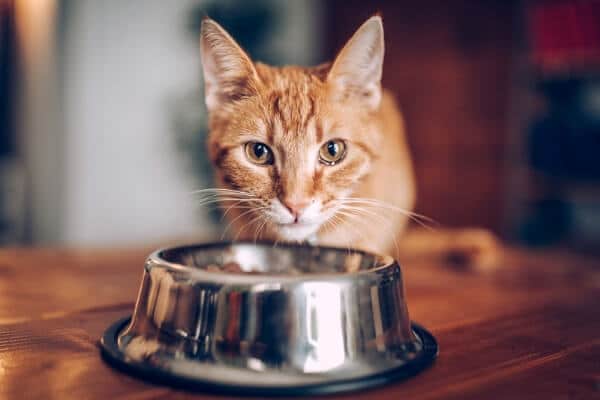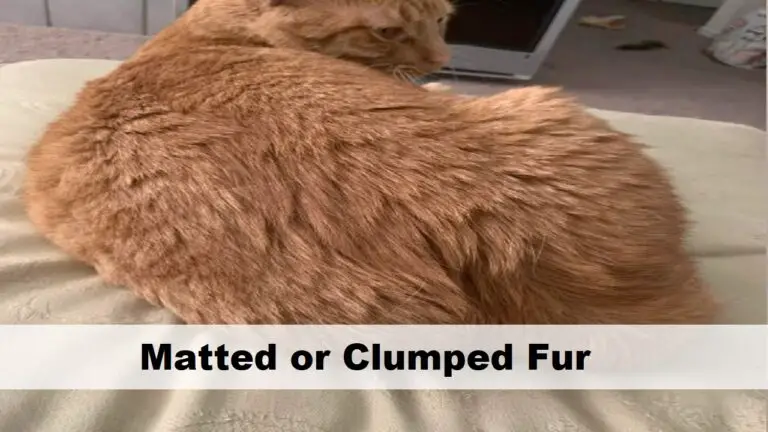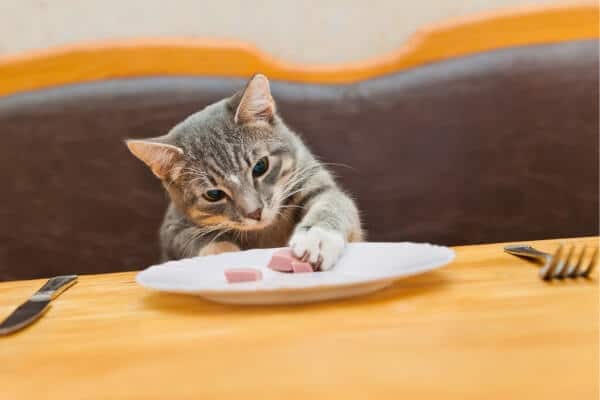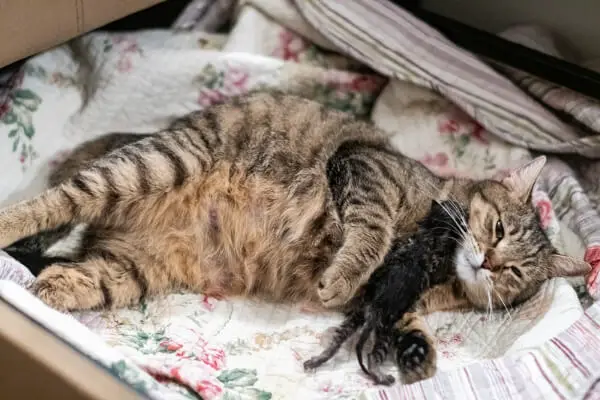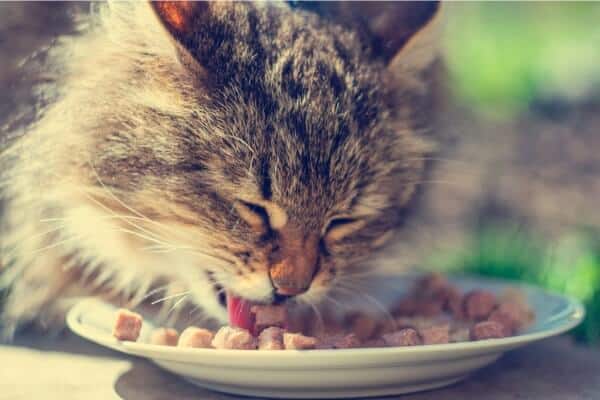My Cat Is Stiff But Still Breathing. What Does It Mean?

Your cat is not just a pet; it’s an integral part of your life, a silent confidant, and a source of unconditional love. So, when you notice your cat has become unusually stiff but is still breathing, anxiety is bound to creep in. Is it simply a temporary condition or is your cat dying?
Stiffness in a cat that is still breathing can be a symptom of multiple issues like seizures, hypokalemia (low potassium levels), trauma, poisoning, pain, infection, paralysis, stress, or even certain neurological disorders. In all scenarios, it’s crucial to understand that this is a clear signal that your cat is not feeling well or may be on the verge of dying.
The fact that your cat is breathing doesn’t necessarily imply it’s out of danger. Some conditions can rapidly deteriorate if left untreated. Therefore, anytime you notice a sudden change in your cat’s behavior or physical condition, professional veterinary assistance should be your first point of call.
Read Also: Cat Died After Teeth Cleaning [Possible Reasons & What To Do]
What Does It Mean When A Cat Is Stiff But Still Breathing?
There are numerous reasons why a cat might become stiff but still be breathing, ranging from relatively benign conditions to more severe health issues.
1. Your Kitty Is Sick Or May Be Dying
When a cat is stiff but still breathing, it might be a sign that the animal is seriously ill or potentially nearing the end of its life. The stiffness could be due to a lack of energy or discomfort that comes with sickness. In extreme cases, it might be a sign of impending death, as some cats might become immobile and unresponsive in their final hours.
Diseases such as cancer, organ failure, or severe infections can lead to such signs. Chronic conditions may gradually sap your cat’s strength and vitality, resulting in a stiffness that’s far removed from its usual agile and playful demeanor.
While it’s heart-wrenching to contemplate, understanding that your cat may be seriously ill or dying can help you provide comfort and maintain quality of life in their remaining time. It’s essential to manage their symptoms, make them comfortable, and show them love.
2. Seizures
Cats, like humans, can experience seizures due to a variety of reasons. A seizure is a sudden, uncontrolled electrical disturbance in the brain. When a cat has a seizure, it might show signs such as falling to the side, making paddling motions with its legs, salivating excessively, fainting, or losing bladder or bowel control.
Sometimes, a cat might become very stiff and rigid during a seizure, which is known as a tonic seizure. This might happen for a few seconds to a couple of minutes. The cat’s breathing might also seem unusual during a seizure – it might become rapid, shallow, or even pause momentarily.
3. He Is In Pain
Cats are immensely good at masking their discomfort. A stiff posture can be a telltale sign of pain, as the cat is trying to limit its movement to avoid exacerbating the distress. Conditions such as arthritis, trauma, or even internal diseases could result in pain leading to stiffness.
Cats may also show behavioral changes when in pain, such as hiding in corners, loss of appetite, and decreased activity. It’s crucial to monitor any such changes in your cat’s behavior along with the stiffness to determine if pain is a probable cause. Your vet can prescribe specific medication suitable for them, and advise on changes in their living conditions to make them more comfortable.
4. Poisoning (Your Cat May Have Eaten Something Toxic)
Cats are naturally curious and might ingest a wide variety of harmful substances, including certain human foods, antifreeze, plants, cleaning chemicals, anticoagulant rodenticides or even certain medications. In such cases, your cat’s body might stiffen as it battles the discomfort caused by the toxins.
Symptoms of poisoning can vary depending on the substance ingested, but may also include vomiting, diarrhea, salivation, restlessness, and in severe cases, seizures. If you suspect your cat has ingested something toxic, it’s important to identify what it was, as this can significantly influence the treatment approach.
Treatment typically involves removing the poison from the body and managing the symptoms. In some cases, your vet may use activated charcoal to absorb the poison or administer specific antidotes.
5. Trauma
Physical trauma, such as being hit by a car, falling from a height, or severe fights with other animals, can cause your cat to become stiff. The stiffness might be due to the pain associated with injuries or the body’s protective response to trauma.
The signs of trauma in a cat can range from obvious external injuries such as cuts and bleeding to less visible signs like stiffness, limping, and changes in behavior. If your cat experiences a traumatic event, examine her as soon as possible, as internal injuries can sometimes go unnoticed. The treatment will depend on the nature of the trauma. It could involve surgery for serious injuries, medication for pain and inflammation, and lots of rest and care.
6. Viral, Bacterial, or Parasitic Infections
Infections caused by viruses, bacteria, or parasites can cause your cat to become stiff. These pathogens can affect various body systems, including the muscles and joints, the nervous system, or even the cat’s overall energy levels.
In addition to stiffness, signs of infection might include fever, loss of appetite, lethargy, and in some cases, specific signs like coughing, sneezing, or skin lesions. You may need to identify the type of infection to administer appropriate treatment.
Infections are typically treated with medications, such as antibiotics for bacterial infections, antiviral drugs for viral infections, or antiparasitic treatments for parasite infestations. Providing a stress-free environment, a balanced diet, and ensuring your cat stays hydrated are also crucial for recovery.
7. Hypokalemia
Hypokalemia, or low potassium levels in the blood, is a condition that can lead to stiffness in cats. Potassium is crucial for muscle function, and a deficiency can lead to muscle weakness and stiffness, among other symptoms.
Signs of hypokalemia might also include lethargy, loss of appetite, and in severe cases, collapse. Chronic kidney disease is one common cause of hypokalemia in cats, although other health issues can also lead to this condition.
Treating this involves addressing the underlying cause, if possible, and supplementing potassium. This might be done through a change in diet, oral supplements, or in severe cases, intravenous administration of potassium.
8. Paralysis
Paralysis, whether partial or full, can also lead to stiffness in cats. It can occur due to various reasons, including trauma, neurological diseases, or certain types of poisoning. Paralysis might affect one part of the cat’s body or could be generalized.
Signs of paralysis include; an inability to move certain limbs, a lack of coordination, or difficulty standing or walking. In some cases, paralysis might also affect other body functions, depending on the underlying cause.
Treatment will depend on the cause of the paralysis. It could involve medications, surgery for certain conditions, physical therapy, and in some cases, assistive devices like carts for mobility.
9. Stress
When a cat is stressed, it might freeze or become rigid as a response. Various things can cause stress in them including changes in their environment, conflict with other animals, or health issues.
Apart from stiffness, signs of stress in cats might include changes in behavior, such as hiding, aggression, or changes in eating or litter box habits. It’s important to identify and address the source of stress to help your cat feel more at ease.
Managing stress involves providing a stable, safe environment for your cat, providing plenty of stimulation through play and enrichment, and in some cases, using calming products like pheromone diffusers.
10. Arthritis And Dysplasia
Arthritis and dysplasia are common causes of stiffness especially in older cats. These conditions affect the joints, leading to pain, inflammation, and difficulty moving.
Signs of these conditions might include limping, difficulty jumping or climbing stairs, and changes in grooming habits, due to the pain associated with movement. Unfortunately, these conditions are often underdiagnosed in cats, as they are very good at hiding their pain.
Treatment typically involves managing the symptoms, as there is no cure for these conditions. This can include medications for pain and inflammation, changes in diet, and modifications to the cat’s environment to make it easier for them to move around.
11. Obesity
Obesity can lead to stiffness in cats, as carrying excess weight puts strain on their joints and muscles. Overweight cats often have difficulty moving around and might appear stiff as a result.
Apart from stiffness, signs of obesity in cats might include difficulty grooming, shortness of breath, and an inability to perform normal activities like jumping or climbing. Obesity can also lead to various health issues, like diabetes and heart disease.
The treatment of obesity involves a change in diet to reduce calorie intake and increase the proportion of healthy nutrients. Increasing the cat’s physical activity can also help them lose weight. It’s important to approach weight loss gradually and under the guidance of a veterinarian, as rapid weight loss can lead to other health issues in cats.
Knowing which of these signs to look for can help you determine whether your cat is simply uncomfortable or if it’s dealing with something more serious that warrants immediate attention.
Take Your Cat To The Vet Immediately
The need to take your cat to the vet when they exhibit unusual symptoms, such as stiffness, is critically important. Cats, being the independent and somewhat secretive creatures that they are, have an instinctual tendency to hide their discomfort or illness. This means that by the time physical symptoms such as stiffness become apparent, the underlying issue might have already progressed significantly. A vet is equipped with the knowledge, experience, and tools necessary to properly diagnose and treat your pet, ensuring their best chance at a full recovery.
Neglecting to take your cat to the vet promptly can result in a variety of negative outcomes. Without prompt attention, what may initially be a manageable health issue can rapidly escalate into a life-threatening situation. The prognosis for many diseases worsens the longer they go untreated. Moreover, a delay in treatment can mean prolonged discomfort, uneasiness, or pain for your feline friend. Even if the cause of the symptoms is not immediately life-threatening, failing to address it promptly can negatively impact your cat’s quality of life.
Veterinary intervention plays a pivotal role in managing your cat’s health, especially in situations where your cat is stiff yet still breathing. Vets can conduct a range of diagnostic tests, including blood tests, x-rays, or ultrasounds, to identify the underlying cause of the stiffness. They can also check for signs of diseases that aren’t immediately visible to the untrained eye. Additionally, they are equipped to administer emergency care, which can be life-saving in instances of severe illness or trauma.
Moreover, a vet can prescribe a suitable treatment plan tailored specifically to your cat’s condition. This could range from medication to manage pain or fight infections, to surgery for more severe cases. They can also provide advice on how to manage chronic conditions and provide recommendations for any necessary changes in diet or lifestyle. Ultimately, a vet can not only treat your cat’s immediate symptoms but also guide you in implementing long-term strategies to improve and maintain your cat’s health.
Signs That Your Cat Is About To Die
If you are concerned that your feline companion may be leaving you soon, there are certain signs that they exhibit.
1. Extreme Weight Loss
Serious illnesses can often cause cats to lose weight rapidly by different means, including decreased appetite, loss of muscle mass, or the body’s increased metabolic demand in its struggle against illness.
Significant weight loss can manifest physically and can also alter your cat’s eating habits. Your cat may show decreased interest in food or have difficulty eating. Persistent weight loss, despite providing adequate nutrition, should be a cause for concern, and while it doesn’t necessarily mean death is imminent, it warrants immediate veterinary consultation to rule out serious health issues.
2. Difficulty Breathing
Difficulty breathing, or dyspnea, is another sign that a cat may be critically ill. Respiratory distress may present itself in various forms such as rapid breathing, gasping for air, or the cat keeping its mouth open while breathing. This can be due to conditions like heart disease, lung disease, or fluid build-up in the chest.
Breathing difficulties can significantly reduce your cat’s quality of life as it might limit their ability to perform regular activities. Moreover, it can lead to a lack of oxygen in the body, which can cause various organ systems to fail. Any noticeable change in your cat’s breathing pattern should be brought to the attention of a vet immediately.
3. Loss of Interest in Everything
A drastic shift in your feline’s behavior, where they suddenly show a loss of interest in everything, can be a sign that they are not well. This could manifest as a lack of interest in playing, a reduced response to stimuli, or even neglecting their grooming habits. Cats, being typically curious creatures, are usually engaged with their surroundings, and a sudden change can be a red flag.
This behavior could be due to physical discomfort, depression, or a general sense of malaise due to illness. While all cats have their off days, a prolonged period of disinterest is something that needs to be addressed.
4. Excessive Hiding
Cats are known to be solitary and can often seek a quiet place when they want some alone time. Excessive hiding behavior is especially concerning when it’s combined with other changes in behavior or physical health.
Cats often hide when they’re feeling sick or when they’re in pain. This is an instinctual behavior intended to protect them from potential predators when they’re in a weakened state. Therefore, if your feline companion is hiding more than usual and showing other signs of illness, it might be a sign that they’re nearing the end of their life.
5. Constant Pain
Another sign that a cat may be critically ill is the presence of constant pain. Cats are experts at hiding their discomfort, but certain signs might indicate they are in pain. This includes unusual postures, such as the “praying position,” where a cat extends its front legs while keeping its rear end up in the air, decreased activity, or reluctance to be touched.
Pain can be due to various ones including arthritis, dental disease, or serious conditions like cancer. Chronic pain can significantly impact a cat’s quality of life, and managing this pain becomes a priority.
How Can You Tell From Rigor Mortis How Long A Cat Has Been Dead?
Why Is Cat Limping And With Stiff Back Legs?
Your feline limping, particularly with stiffness in the back legs, is an indication of several health issues. One of the most common causes is trauma, which could be due to a fall, accident, or fight with another animal. Your cat may have sprained or fractured a leg or injured a joint, resulting in pain and stiffness.
It could also be arthritis, a condition characterized by inflammation and degeneration of the joints. This is especially common in older cats, leading to chronic pain, stiffness, and difficulty moving. Additionally, conditions such as diabetes and heart disease can cause limping and stiffness. Diabetes can lead to a condition known as diabetic neuropathy, which affects the nerves in the hind legs.
In some cases, limping and stiffness in a cat’s back legs could signal a severe condition called saddle thrombus or feline aortic thromboembolism (FATE). This condition occurs when a blood clot forms and obstructs blood flow to the hind limbs. Symptoms of this include severe pain, paralysis, and cold rear limbs. This is a medical emergency requiring immediate veterinary attention.
Why Is My Cat’s Dead Body Stiff?
The stiffness you’re noticing in your cat’s body is due to a natural process called rigor mortis. Rigor mortis is a physiological phenomenon that occurs in all mammals after death, including humans and cats. It begins shortly after death and is the result of chemical changes within the muscles.
When a creature is alive, its muscles contract and relax due to the interaction between two proteins: actin and myosin. After death, this process stops as the cells are no longer producing energy. Without energy, the myosin molecules adhere to the actin filaments, causing a stiffening of the muscles, which is observed as rigor mortis.
This rigidity usually starts affecting the smaller muscles first, like those in the jaw, progressing to the larger muscles in the body, and eventually making the whole body stiff. Rigor mortis typically sets in within 1 to 4 hours after death and can last up to 24 hours – 36 hours, after which the body will gradually return to a limp state. It’s a temporary condition and is a normal part of the post-mortem process.
Final Thoughts
Recognizing changes in your feline friend’s body can often feel like a guessing game. The sudden stiffness in your cat, even while it continues to breathe, may leave you puzzled and concerned. Yet, this article has highlighted the numerous possibilities behind such a condition, from general sickness, pain, and stress to severe ailments like poisoning, paralysis, or hypokalemia.
As pet owners, our primary responsibility is to ensure our pets’ health and happiness. Awareness and quick response to changes in your cat’s behavior, such as stiffness are crucial for the early detection and treatment of potential health issues. Therefore, It is always essential to consult with a vet to get an accurate diagnosis and effective treatment plan.
The journey of feline ownership is filled with joy, companionship, and, at times, worry over their wellbeing. While stiffness in your cat can indicate various issues, timely intervention and the right care can ensure your feline friend continues to purr, play, and fill your life with their unique charm.
Related Articles
Read related posts about

